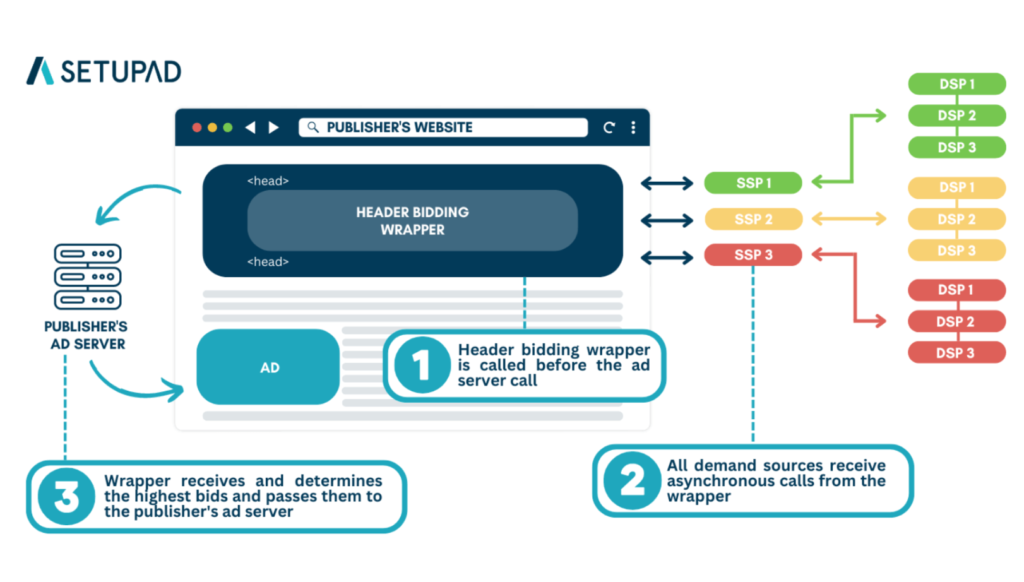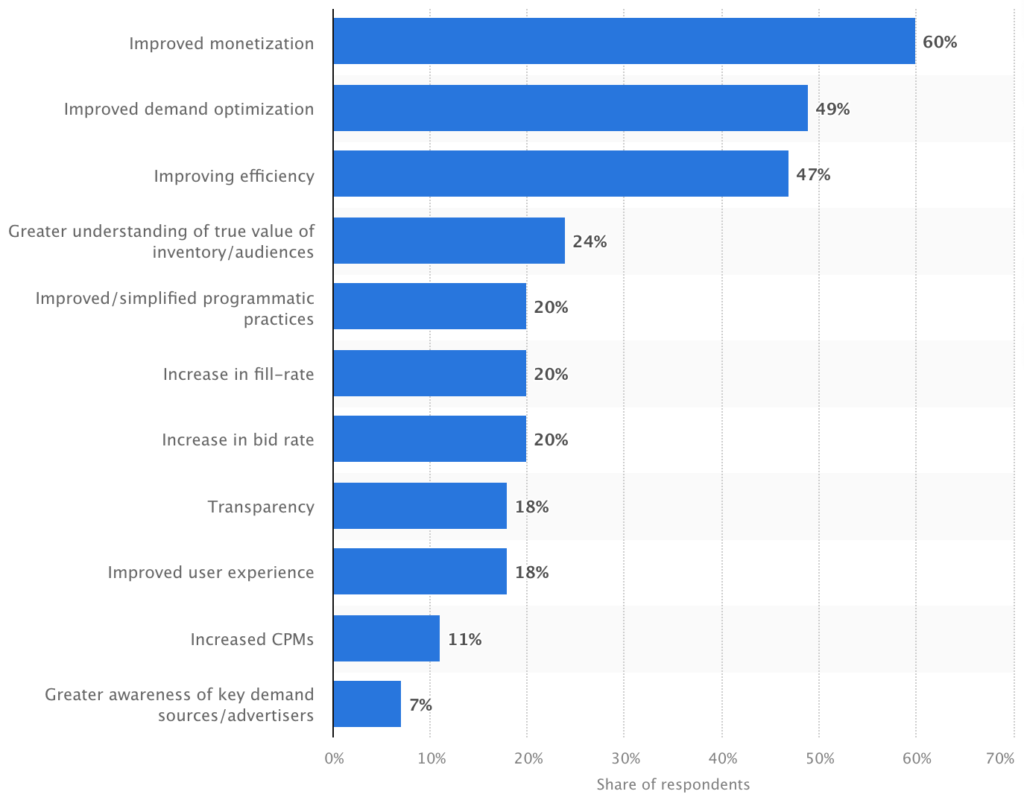What is a Header Bidding Wrapper?
Header bidding wrapper allows publishers to request real-time bids from numerous demand partners, using the code placed at the website’s header to scan all accessible inventory.
This article explains what header bidding wrapper is, what are its types and advantages, and how it can benefit your header bidding solution.
Short Recap for Header Bidding
Header bidding plays an important role in improving ad revenue for most publishers and is a gold standard of programmatic advertising.
One of the greatest drawbacks of the time-consuming waterfall has been overcome by header bidding, which enabled publishers to sell all ad inventory to the highest bidder at scale.
What is header bidding?
Header bidding is an advanced form of programmatic advertising that enables publishers to simultaneously offer their ad inventory to a number of ad networks and ad exchanges.
In simple terms, it’s a programmatic auction in which bid requests are delivered in real-time to multiple demand partners in order to increase the value of ad inventory.
One of the main advantages of header bidding for publishers is greater yield. Publishers can sell inventory on a per-impression basis because header bidding enables a simultaneous auction from all the bidders.
How does header bidding work?
Header bidding starts as soon as the page loads in the user’s browser.
Before sending the request to the ad server, the header bidding code in the page header executes and simultaneously calls all demand partners to place a bid on this impression.
All of this occurs within a time range chosen by the publisher, aka the timeout, typically within a second.
The approach is more open and fair to the publisher overall. By allowing various demand partners to compete for the same ad inventory, publishers can sell their ad inventory for the highest price possible.
Header bidding vs waterfall
The main difference between header bidding and waterfall is that header bidding is an automated auction. Publishers offer their inventory to multiple ad exchanges, allowing several demand partners to place simultaneous bids.
In header bidding, as opposed to the waterfall, the highest bid wins.
Waterfall is based on the networks’ past performance in terms of yield (eCPM), fill rate, latency, and other factors. A ladder of ad networks and/or exchanges is arranged from top to bottom in order of performance to the publisher.
Header bidding is considered the new standard for programmatic advertising in 2022, while waterfall is becoming less used. Although, some publishers who rely on direct deals are likely to use it.
What is a Header Bidding Wrapper?
A header bidding wrapper, also known as a container, is a JavaScript (JS) code that stays on the publisher’s website and sends requests to the demand partners to find bids on their behalf.
It helps publishers to control numerous demand partners while setting parameters like the number of bidders and the length of the bid waiting period.
Header bidding wrapper handles the programmatic auction’s rules and organization.
With the help of a header bidding wrapper, publishers can add or delete partners instead of managing and implementing code for every new demand partner.
Additionally, wrappers include a timeout setting that specifies how long the browser waits for bidders to reply.
Publishers who want to increase the number and efficiency of demand for an impression should use header bidding wrappers. It ensures that all bid requests are triggered simultaneously.
Wrappers outperform the waterfall model, which increases page latency by offering ad inventory only to one ad network at a time.
How Does Header Bidding Wrapper Work?
Header bidding wrapper’s primary functions are to gather bids, produce bid requests, and transmit them to the ad server.
These 3 main steps describe how a header bidding wrapper works:
- The user opens the website, which includes the wrapper’s code.
- Header bidding wrapper triggers bid requests to all integrated demand partners simultaneously.
- Demand partners respond with their bids, and the wrapper determines the winning bid and sends it to an ad server (e.g., Google Ad Manager).
After that, the ad server makes the final decision and serves the ad.

Pros and Cons of a Header Bidding wrapper
Here are 5 benefits of using a header bidding wrapper:
- Increased revenue and improved monetization.
- Asynchronous auction.
- Improved page’s leading speed and better user experience.
- Universal timeout.
- Simple demand management. Wrappers can have multiple adapters, which helps you integrate them seamlessly.
- Transparency.
The graph below shows that improved monetization was listed by 60% of U.S. publishers as one of the top three advantages of employing header-bidding wrapper solutions. Improved demand optimization came second, highlighted by 49% of respondents.

Source: Statista
Here are 3 disadvantages of using a header bidding wrapper:
- Technical difficulties. Open-source wrappers have a complex workflow and can require a lot of time and effort to set up on your own. Skilled development resources are needed to understand the wrapper tag technology.
- Configuration difficulties. Understanding how the wrapper functions during the initial setup may require a lot of time and effort. Due to the wrapper’s complexity, if it isn’t set up properly, it may cause performance issues and impact the website’s speed. Therefore, header bidding isn’t suggested if you intend to work with only one demand partner.
- Unsupportive of user interfaces. Some header bidding wrappers may not support some user interfaces (e.g., Prebid.js), so any configuration must be done directly in the wrapper code.
How to Choose a Header Bidding Wrapper?
There are 3 main types of header bidding wrappers–open-source, proprietary, and managed.
All of them can be used to run header auctions on both client and server-side.
Open-source wrappers
Open-source header bidding wrappers are fully available and adaptable code publishers can implement on their websites. An open-source wrapper solution allows publishers to maintain independence and manage their ads.
Open-source is the most scalable solution since ad exchanges and the extensive development community maintain the adapters. The community has access to the source code, which increases transparency and guarantees fair auction dynamics.
Prebid.js is the most popular open-source wrapper. It’s free, making it a popular choice for publishers starting with header bidding.
The main downside is that the open-source wrappers are complicated to implement and require extra resources, including tech experts.
In addition, you need to secure partnerships and manage all demand partners yourself which can be a roadblock for the majority of small-medium publishers.
Proprietary solutions
Proprietary header bidding wrappers are built by ad tech companies from scratch by using their own code. The top SSPs and ad exchanges typically provide a proprietary wrapper solution.
In this kind of solution, header auctions are facilitated by the adtech partner using internal proprietary code.
While open-source solutions can be cheaper, proprietary solutions may come with features that better fit your needs. However, some publishers may be reluctant to use them as they provide less transparency and are more appropriate for enterprise publishers.
Managed solutions
Publishers without the required technical resources, SSPs, and AdOps find a reasonable compromise in using managed wrapper solutions.
Certain managed services are based on both prebid.js and proprietary code.
The wrapper is frequently constructed on top of prebid, which is the finest feature of managed solutions. The benefits include total transparency and additional advantages based on the supplier (e.g., complimentary ad products).
Managed services can offer initial installation support and continuing maintenance regardless of the code used, which lessens the burden on publishers’ developers.
Remember that there are expenses to take into account as well.
Despite being cost-free to utilize, open-source solutions require internal IT and development resources.
Features you should consider when choosing a header bidding wrapper solution
If you have a team of tech experts, you may consider going for an open-source solution with the largest support from demand partners.
Alternatively, managed wrapper solutions may require less input regarding the terms of setup and offer extra services (e.g., analytics).
There are 6 features you should consider when choosing a header bidding wrapper solution:
- Amount of demand partners and the ability to add or remove them.
- Possibility of support and analytics.
- Bid monitoring.
- Discrepancy report and resolution.
- Multi-ad size support.
- Smart timeout.
Why Should You Outsource Header Bidding Wrapper Providers?
Managing header bidding setup requires substantial knowledge and resources for publishers. Therefore many of them outsource it for their revenue management.
Although some wrappers are free, it’s tempting to pay for a wrapper to get a functional tool up and running quickly.
In this scenario, a development team is unnecessary, and the publisher doesn’t need to know about the various modules and available market options.
This enables the programmatic teams to concentrate only on the business.
You should choose a managed service provider, like Setupad, especially if you’re a small or medium-sized publisher without an AdOps team. They will handle your ad operations and bring premium demand to your site.
If you’re a large publisher, you can have a single AdOps expert monitor the overall ad operations and assign most of the work to the managed service provider.
In any case, as a publisher, you know best if header bidding should be outsourced for your site.
There are 4 reasons why you should outsource your header bidding wrapper providers:
- Fast and easy start. Outsourcing your header bidding wrapper allows to speed up the setup process and save you a lot of time and resources.
- Technical support. Header bidding requires a team of tech experts to manage and operate it. A managed wrapper provides a solution for this and adds value by offering support and analytics.
- Lack of scale. SSPs usually can’t afford to serve smaller publishers and are more willing to work with large publishers. Some might be more flexible, but mostly they are strict regarding the thresholds.
- Wrapper optimization and improvement. A managed service provider will always help you to reach your monetization goals with header bidding, and ensure that your website’s speed and the user experience is optimized.
Setupad’s Header Bidding Wrapper–the Best Solution for Publishers
Setupad’s header bidding wrapper is the best choice for the publisher because our solution is optimized, continuously updated, fast and risk-free.
Our solution works on a revenue-share basis, so you can always be sure that our cut will be proportional to your revenue growth.
To display the winning programmatic ads, our tag-based solution conducts a hybrid prebid.js auction that gathers bids from the client and server-side connections. Publishers profit the most while maintaining speed in this way.
It’s simple to implement with an ad server (e.g., Google Ad Manager) and doesn’t require changes to the website’s source code.
Setupad uses the most advanced ad stack in the header bidding solution. At least 35% of the winning bids come through our hybrid header bidding wrapper’s server-to-server connections with the Prebid server, Amazon’s TAM, and Google’s Open Bidding.
We offer exceptional customer service and a customized approach for our customers.
Additionally, Setupad’s Chrome extension for monitoring ads is a helpful and valuable tool to report unwanted ads. Extension gathers the data and sends it to us to successfully restrict the specific advertiser from all demand sources.
Conclusion
Because of header bidding wrappers, publishers can maximize the number of demand partners they would like to have in their auction. Although a wrapper is not required, doing so will speed up the work with many partners and improve communication with ad servers.
Header bidding guarantees that your advertising inventory is sold for a fair price, raises the overall CPM, offers flexibility, and has choices to suit any AdOps team.


